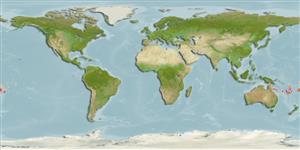>
Blenniiformes (Blennies) >
Blenniidae (Combtooth blennies) > Blenniinae
Etymology: Meiacanthus: Greek, meion = less = lessen + Greek, akantha = thorn (Ref. 45335).
Environment: milieu / climate zone / depth range / distribution range
Ecología
marino asociado a arrecife; rango de profundidad 5 - 21 m (Ref. 86942). Tropical
Pacific Ocean: Fiji and Tonga.
Tamaño / Peso / Age
Maturity: Lm ? range ? - ? cm
Max length : 9.5 cm SL macho / no sexado; (Ref. 54980)
Espinas dorsales (total): 4 - 5; Radios blandos dorsales (total): 26-27; Espinas anales 2; Radios blandos anales: 16 - 17. Lunate caudal fin with elongated lobes in adults; live color dark olive with wedge-shaped, orange-yellow stripe along sides of body; cheek and opercle green; caudal-fin base and lobes black with centroposterior area transparent whitish with dusky rays. Dorsal rays IV-V (usually V), 26-27; segmented caudal rays 11-13 (Ref. 54980).
Adults swim above the bottom. They feed on zooplankton. Oviparous. Eggs are demersal and adhesive (Ref. 205), and are attached to the substrate via a filamentous, adhesive pad or pedestal (Ref. 94114). Larvae are planktonic, often found in shallow, coastal waters (Ref. 94114).
Life cycle and mating behavior
Madurez | Reproducción | Puesta | Huevos | Fecundidad | Larva
Oviparous, distinct pairing (Ref. 205).
Lieske, E. and R. Myers, 1994. Collins Pocket Guide. Coral reef fishes. Indo-Pacific & Caribbean including the Red Sea. Haper Collins Publishers, 400 p. (Ref. 9710)
IUCN Red List Status (Ref. 130435)
Threat to humans
Harmless
Human uses
Más información
ReferenciasAcuiculturaPerfil de acuiculturaRazasGenéticaElectrophoresesheritabilidadEnfermedadesProcesamientoNutrientsMass conversion
ColaboradoresImágenesStamps, Coins Misc.SonidosCiguateraVelocidadTipo de nataciónSuperficie branquialOtolitosCerebrosVisión
Herramientas
Special reports
Download XML
Fuentes de Internet
Estimates based on models
Preferred temperature (Ref.
123201): 25.2 - 27.6, mean 26.2 °C (based on 182 cells).
Phylogenetic diversity index (Ref.
82804): PD
50 = 0.5000 [Uniqueness, from 0.5 = low to 2.0 = high].
Bayesian length-weight: a=0.00562 (0.00258 - 0.01228), b=3.06 (2.87 - 3.25), in cm total length, based on LWR estimates for this (Sub)family-body shape (Ref.
93245).
Nivel trófico (Ref.
69278): 3.4 ±0.45 se; based on food items.
Resiliencia (Ref.
120179): Alto, población duplicada en un tiempo mínimo inferior a 15 meses (Preliminary K or Fecundity.).
Fishing Vulnerability (Ref.
59153): Low vulnerability (10 of 100).
Nutrients (Ref.
124155): Calcium = 137 [71, 239] mg/100g; Iron = 0.846 [0.502, 1.431] mg/100g; Protein = 18.2 [17.0, 19.2] %; Omega3 = 0.0988 [, ] g/100g; Selenium = 21.4 [10.4, 47.3] μg/100g; VitaminA = 245 [83, 762] μg/100g; Zinc = 1.84 [1.21, 2.65] mg/100g (wet weight);
